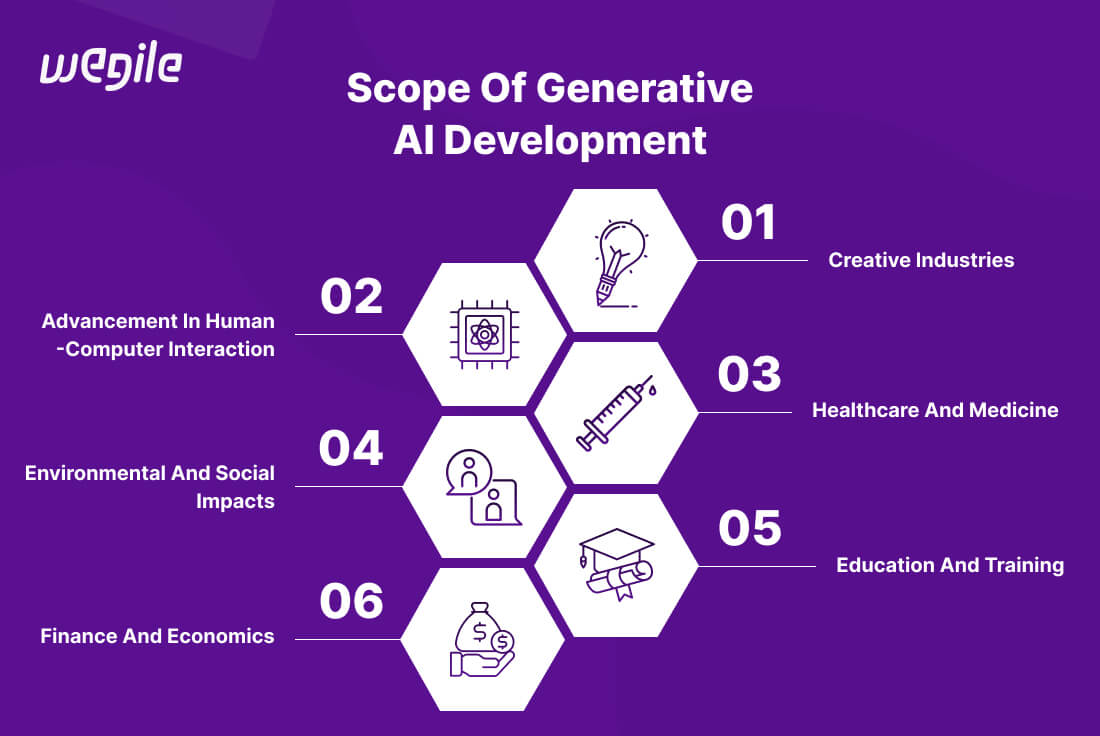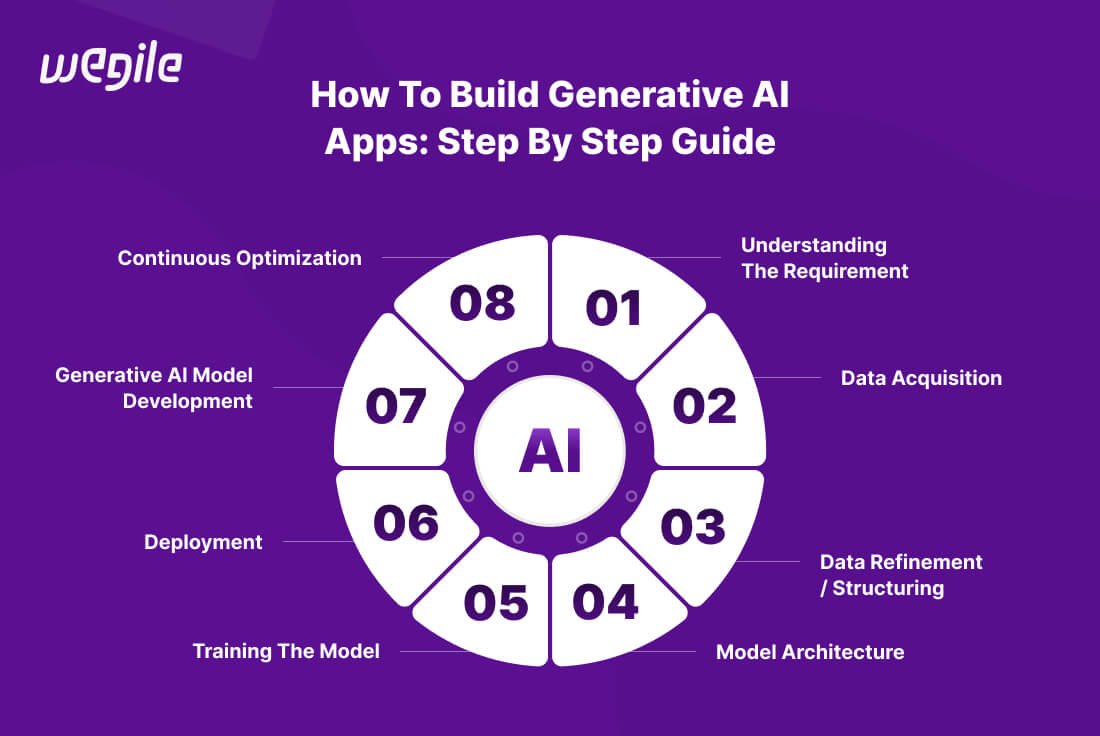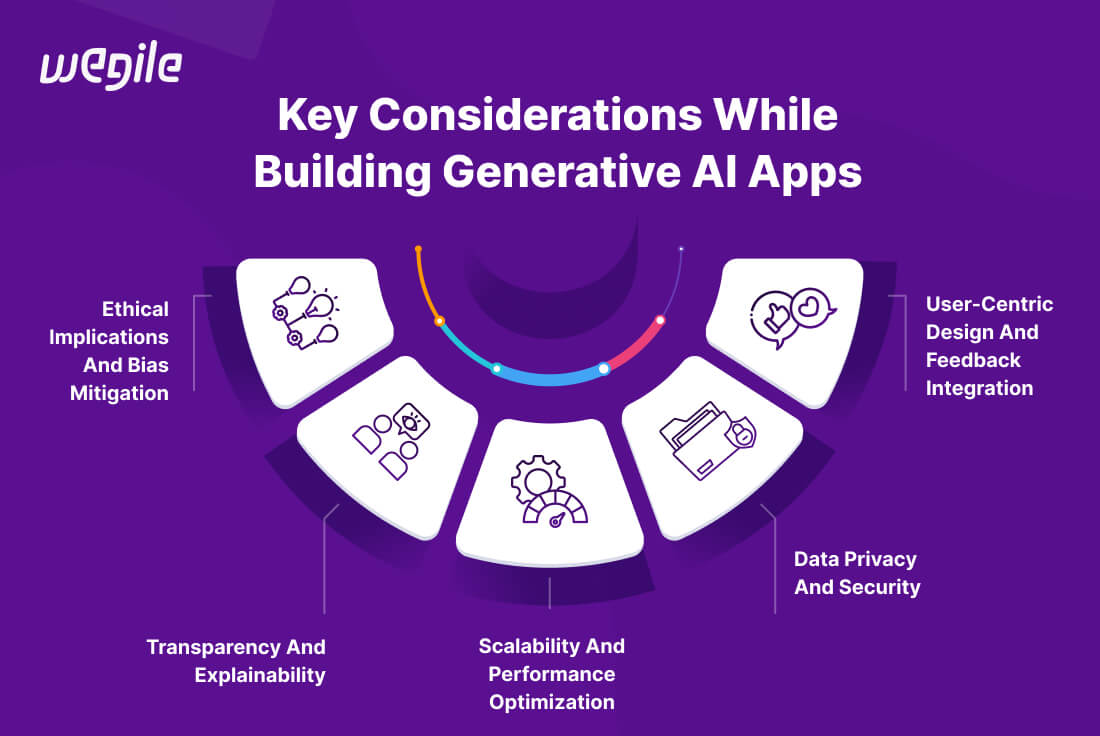The scope of generative AI development today is rapidly expanding due to its transformative benefits. The market size of the generative AI sector is projected to reach an impressive US$36.06 billion in 2024. This market is expected to exhibit a significant annual growth rate (CAGR 2024-2030) of 46.47%, resulting in a staggering market volume of US$356.10 billion by 2030. This substantial growth shows how businesses across various industries are increasingly turning their focus towards the adoption of generative AI technologies. For businesses to take advantage of generative AI, it is crucial to build solutions that are tailored to meet specific business needs. However, it involves a comprehensive understanding of both the technical and practical aspects to leverage generative AI's full capabilities for a competitive edge. In this blog, we will learn how to build generative AI apps.

First, before understanding the intricacies of how to build generative AI apps, it's important to understand the scope of generative AI development. This field is vast and continually expanding, driven by advancements in machine learning, increasing computational power, and the growing availability of data. Let’s understand how technological transformation is reshaping industries and creating new possibilities.
Generative AI is revolutionizing the creative industries by enabling the production of fresh content with minimal human intervention. This technology is being harnessed to generate art, music, and even entire virtual worlds.
Art and Design: Artists and designers use generative AI to create unique artworks and designs. AI algorithms can generate patterns, textures, and even entire compositions that push the boundaries of traditional art forms. This fusion of human creativity and AI capabilities leads to innovative and unexpected artistic expressions.
Music Composition: In the music industry, AI models are composing original pieces, blending different genres, and even creating music tailored to specific moods or events. These AI-generated compositions can serve as an inspiration for musicians or be used directly in various media applications.
Content Creation: Generative AI is also making significant progress in content creation, generating articles, stories, and scripts. These AI-generated texts can be used to draft initial versions of written content, save time for writers, and provide new ideas and perspectives.
The healthcare industry is leveraging generative AI to improve patient outcomes, streamline medical research, and enhance diagnostic processes.
Drug Discovery: AI models are being used to generate new molecular structures, accelerating the drug discovery process. By simulating how different compounds interact with biological targets, generative AI can identify promising drug candidates more quickly and cost-effectively.
Medical Imaging: In medical imaging, generative AI algorithms enhance image resolution, fill in missing data, and even generate synthetic images for training diagnostic models. This improves the accuracy and efficiency of medical diagnoses and treatments.
Generative AI is reshaping the education sector by creating customized learning experiences and developing advanced training tools.
Personalized Learning: AI models can generate personalized educational content based on individual learning styles and progress. This ensures that each student receives tailored instruction that addresses their specific needs and paces.
Virtual Tutors: Generative AI powers virtual tutors that can provide real-time assistance, generate practice problems, and offer explanations in multiple languages. These tutors enhance the learning experience by making education more accessible and interactive.
Simulation-Based Training: In fields like medicine, aviation, and engineering, generative AI can create realistic simulation environments for training purposes. These simulations allow trainees to practice complex procedures and scenarios in a safe, controlled setting.
The role of generative AI in financial services is huge. It is transforming how data is analyzed, predictions are made, and decisions are executed.
Algorithmic Trading: AI-driven trading algorithms generate strategies based on vast amounts of financial data, identifying patterns and trends that may be invisible to human traders. These algorithms are capable of executing trades with unparalleled speed and efficiency, surpassing what humans can achieve.
Risk Management: Generative AI models simulate various financial scenarios to predict and manage risks. This helps financial institutions prepare for potential market changes and develop strategies to mitigate adverse outcomes.
Fraud Detection: By generating synthetic data that mimics fraudulent activity, AI models can train on more comprehensive datasets, improving the accuracy of fraud detection systems.
Generative AI is being used to address some of the most crucial environmental and social challenges.
Climate Modeling: AI models can generate detailed climate predictions, helping scientists understand the potential impacts of climate change and develop strategies to mitigate its effects. These models consider a wide range of variables and scenarios, providing more accurate and actionable insights.
Sustainable Design: Generative AI plays a crucial role in architecture and urban planning, enabling the creation of sustainable buildings and cities that prioritize energy efficiency, resource utilization, and minimizing environmental impact. These AI-generated designs can lead to more sustainable and livable environments.
Social Good: Generative AI is used in various social good initiatives, such as generating synthetic data to improve privacy while enabling research, creating educational content for underserved communities, and developing tools for humanitarian aid and disaster response.
Generative AI is at the forefront of enhancing human-computer interaction (HCI), making technology more intuitive and responsive to human needs.
Natural Language Processing (NLP): AI models generate human-like text and speech, improving the capabilities of chatbots, virtual assistants, and language translation services. This leads to more natural and effective communication between humans and machines.
Augmented and Virtual Reality (AR/VR): Generative AI creates immersive virtual environments and augmented reality experiences. These technologies are used in gaming, training, and remote collaboration, enhancing how people interact with digital content.
User Interface Design: AI generates adaptive user interfaces that adjust to user preferences and behaviors. This personalization improves user experience by making software applications more intuitive and user-friendly.
The scope of generative AI development is continually expanding, offering innovative solutions across various industries. Now that we have thoroughly examined the broad nature of generative AI development, let's look into how to build generative AI apps.


Understanding the requirement is the foundational step in the generative AI development process. This involves several critical activities to ensure the project's alignment with the goals and needs of stakeholders.
Defining the Problem: The first task is to clearly define the problem that the generative AI application aims to solve. This involves engaging in detailed discussions with stakeholders to understand their pain points and the specific outcomes they are looking to achieve. A well-defined problem statement guides the entire development process, ensuring the solution is focused and effective.
Use Case Selection: Identifying the appropriate use case for generative AI is crucial. Generative AI can be applied in various domains, such as image generation, code generation, predictive analysis, content creation, virtual assistants, synthetic data generation, and more. Depending on the specific needs and objectives, the use case is selected. This ensures that the development efforts are directed towards creating a solution that provides maximum value. For example, if the aim is to automate creative tasks, an image generation use case might be selected, whereas predictive analysis could be the focus for improving business decisions.
Setting Goals and Outcomes: Establishing clear, measurable goals and expected outcomes is essential. These goals serve as benchmarks for success and help in tracking progress throughout the development process. Goals might include improving user engagement, increasing automation efficiency, or generating high-quality creative content. Having well-defined outcomes ensures that the development stays aligned with the desired results and provides tangible benefits to the users.
Data acquisition is a pivotal step in developing a generative AI application. This phase involves collecting and storing large volumes of data, which are fundamental for training AI models.
Source Identification: The process of data collection begins with identifying various data sources relevant to the chosen use case. Data can come from public datasets, proprietary databases, web scraping, social media feeds, and user-generated content. The quality and relevance of the data are critical to the success of the AI model. A diverse dataset helps the model generalize better across different scenarios.
Data Variety: Ensuring the data encompasses various scenarios and variations is vital. This diversity enhances the model’s ability to perform well in different contexts. For instance, if the use case is image generation, the dataset should include different images under different conditions and styles.
Data Volume: Accumulating a sufficient volume of data is crucial for effective model training. More data typically leads to better performance, provided it is relevant and high-quality. Employing automated and manual data collection methods helps to amass comprehensive datasets that support robust model training.
Scalability: Given the potentially vast amount of data, scalable storage solutions are necessary. Cloud storage provides the flexibility to scale up as the data volume increases, ensuring efficient data management and access. This scalability is crucial for handling the extensive datasets required for training generative AI models.
Reliability: Reliable storage solutions ensure that the data is always accessible and secure. High reliability and uptime are essential for continuous development and model training processes. Robust data management practices, including regular backups and redundancy, safeguard the data against loss and ensure its integrity.
Data Management: Effective data management is key to handling large datasets efficiently. This involves organizing the data into structured formats, implementing access controls, and monitoring data usage. Proper data management ensures that the data is readily available for model training and other development activities, enhancing the overall efficiency of the process.
Once data is collected, the next critical phase in the generative AI development process involves refining and structuring this data to make it usable for model training. This step ensures that the data is clean, organized, and ready to deliver optimal results.
Data Cleaning: Raw data often comes with various issues, such as noise, errors, and inconsistencies. The process begins with meticulous data cleaning, where these issues are addressed to enhance data quality. This includes handling missing values, correcting erroneous entries, and removing duplicates. Ensuring that the data is accurate and reliable sets the foundation for robust AI model performance.
Data Structuring: After cleaning, the data often needs to be organized into a structured format. This involves transforming unstructured data into a format that is easily processed by AI models. For instance, text data might be tokenized for natural language processing tasks, numerical data might be normalized, and categorical data might be labeled appropriately. Proper structuring streamlines the training process and significantly improves the efficiency and effectiveness of the model.
Through rigorous data refinement and structuring, the dataset is prepared to ensure it is optimized for the next stages of AI development, ultimately leading to better model accuracy and reliability.
The architecture of the generative AI model is a critical component of the development process, tailored to meet the specific needs of each project. The appropriate Large Language Models (LLMs) will be selected according to the use case. For example, if the objective is to generate recommendations, dedicated LLM models designed for recommendation tasks will be chosen. Each use case, whether it involves text generation, image generation, predictive analysis, or other applications, demands a specific model that excels in the given area.
After that, initial queries are run on both the clean data and the specific ML file to generate preliminary output files. This is a crucial step to verify that the model and data are correctly aligned and that the setup is functioning as expected. The output from these initial queries provides valuable insights into any potential issues or adjustments that might be necessary.
This process is certainly not a one-time activity but rather a continuous and ongoing one. The initial results are analyzed and used to fine-tune the model. Queries are run multiple times, each iteration helping to refine the output further. This repetitive querying and refining process is essential to achieve optimal performance and high-quality results. By continuously iterating, the model learns and adapts, ensuring that the final outputs meet the desired standards and expectations.
Training the model is a pivotal phase in the generative AI development process, where the selected AI model learns from the refined data to perform the desired tasks accurately. This stage involves multiple iterations to ensure the model's effectiveness and precision.
Training the AI model begins by feeding it the cleaned and structured data. The model processes this data to identify patterns, relationships, and features that are essential for generating accurate outputs. This initial training phase involves running numerous iterations where the model adjusts its parameters based on the data it encounters. The goal is to minimize errors and improve the model's generalization ability from the training data to new, unseen data.
However, simply running queries and processing data is not enough for the model to achieve high accuracy. Rigorous training is required, which involves fine-tuning the model's parameters and structure. This fine-tuning process is crucial for enhancing the model's performance and ensuring it meets the specific requirements of the use case. It often requires running large-scale queries multiple times, each time making slight adjustments to the model to improve its output.
During this phase, the model's performance is continuously monitored and evaluated using a validation dataset. This separate set of data, which is not used in training, helps assess how well the model generalizes to new data. The evaluation metrics guide the adjustments needed in the model's parameters and architecture. By iterating through this training and evaluation cycle, the model gradually improves, becoming more accurate and reliable.
Fine-tuning continues until the model's output matches the desired outcomes. This iterative process ensures that the AI model, apart from being functional, is optimized for performance, providing high-quality results that align with the project's goals.
Once the model is thoroughly trained and fine-tuned, the next step is deployment. Deploying the AI model involves setting it up in a production environment where it can be accessed and utilized by end-users. This stage ensures the model is operational and can deliver its intended functionality in real-world scenarios.
The deployment process begins by finalizing the trained model and preparing it for integration with the application’s backend. This involves configuring the model to handle real-time data inputs and generate outputs accordingly. The model is then set up on a server or cloud environment that supports scalability and reliability, ensuring it can handle varying loads and user demands.
After deploying the AI model, the next phase focuses on developing the generative AI model, making it accessible and usable through an interactive interface. This involves creating both frontend and backend components to facilitate seamless user interactions with the AI system.
The frontend development phase involves designing and building a user interface (UI) that allows users to interact with the generative AI model. Depending on the project requirements, this could be a web dashboard, a mobile app, or a desktop application.
The frontend allows users to input their data or queries, which are then processed by the backend system that interacts with the deployed AI model. The UI should be intuitive, user-friendly, and designed to meet the specific needs of the target audience.
For instance, if the AI model is designed to generate text or images, the frontend interface collects the user's input, sends it to the model via API calls, and displays the generated output to the user.
The frontend design should prioritize user-friendly functionality, allowing for seamless data input, result viewing, and the option for additional queries. The UI should offer precise guidance and prompt responses to assist users in comprehending how to engage with the AI model efficiently.
In the backend, robust systems are developed to handle API calls to the AI model. This involves setting up servers, databases, and other infrastructure components that support the real-time processing of user queries.
The backend system ensures that the user inputs are correctly formatted and sent to the AI model, and the generated outputs are returned to the front end for display.
At the backend, API calls are made to the AI model to retrieve responses based on the user inputs. These APIs facilitate seamless communication between the frontend interface and the AI model, ensuring that the interaction is smooth and efficient.
For example, if the AI model generates images, the backend will process the user's input, send it to the AI model, retrieve the generated image, and send it back to the frontend for the user to view. This process needs to be optimized for speed and reliability to provide a smooth user experience.
APIs (Application Programming Interfaces) are developed to facilitate communication between the front end and the AI model. These APIs handle requests and responses, ensuring that data flows seamlessly between the user interface and the AI backend. They also manage authentication, authorization, and other security measures to protect user data and ensure secure interactions with the AI model.
By combining a well-designed frontend with a robust backend and efficient APIs, the generative AI model becomes fully operational and accessible to users. This development phase ensures that the AI system is fully efficient yet also intuitive, providing an engaging and effective experience for end-users.
The process of generative AI app development does not end here! Continuous optimization is essential to ensure that the generative AI solution remains relevant and performs optimally over time. This involves regularly updating the model, refining its outputs, and adapting to new data and user requirements.
Continuous monitoring of the AI model’s performance is crucial. This involves tracking key metrics such as accuracy, response time, and user satisfaction. Regular maintenance checks help identify any issues or areas for improvement, ensuring the model remains reliable and effective.
For example, if the AI model's performance degrades due to new types of input data, adjustments can be made to the model or the training data to restore its accuracy. Automated monitoring tools can alert the development team to any significant changes in performance, allowing for timely interventions.
As new data becomes available, the AI model needs to be retrained to incorporate this data and improve its predictions and outputs. This continuous learning process ensures that the model stays current with evolving trends and user behaviors. Regular updates help the model adapt to new challenges and provide better results over time.
User feedback is invaluable for continuous optimization. Collecting and analyzing feedback from users helps identify pain points and areas for enhancement. This feedback can be used to fine-tune the model, improve the user interface, and add new features that enhance the overall user experience.
The optimization process is iterative, involving cycles of testing, feedback, and refinement. Each iteration aims to enhance the model’s performance, reliability, and user satisfaction. This approach ensures that the generative AI solution continuously evolves to meet the changing needs of its users and the dynamic landscape of AI technology.
By implementing continuous optimization practices, the generative AI solution remains at the forefront of innovation, delivering consistent value and high-quality results to its users. This commitment to ongoing improvement ensures long-term success and relevance in the rapidly evolving field of AI technology.

| Sr No | Key Functionality | Tech Stack | Description |
|---|---|---|---|
| 1 | Programming Language | Python, R, Julia | Python is the most widely used language in AI development due to its simplicity and extensive libraries like TensorFlow, PyTorch, and sci-kit-learn. R is preferred for statistical analysis and data visualization, while Julia is gaining popularity for its high performance and speed in numerical computing. |
| 2 | Cloud Storage | Amazon S3, Google Cloud Storage, Azure Blob Storage | Cloud storage solutions provide scalable, reliable storage options essential for handling large datasets used in generative AI. These services ensure data is securely stored and easily accessible for processing and analysis. They offer high availability, durability, and integrations with other cloud services for seamless workflow management. |
| 3 | Database | MongoDB, PostgreSQL, MySQL | Databases are crucial for storing and managing structured data. MongoDB is a NoSQL database known for its scalability and flexibility. PostgreSQL and MySQL are relational databases that offer robust querying capabilities, transaction management, and data integrity features, making them suitable for diverse AI applications. |
| 4 | Model Deployment | TensorFlow Serving, TorchServe, Docker | Model deployment tools like TensorFlow Serving and TorchServe facilitate the deployment of AI models in production environments. Docker enhances deployment by containerizing the models, ensuring consistent environments across different stages of development and production, thereby simplifying scalability and management. |
| 5 | Deep Learning Framework | TensorFlow, PyTorch | TensorFlow and PyTorch are highly flexible frameworks for building and training deep learning models. They support a wide range of AI tasks, from basic neural networks to complex generative models. TensorFlow offers extensive libraries and tools for customization and optimization, while PyTorch is known for its dynamic computation graph and ease of use. |
| 6 | Model Hub | Hugging Face | Hugging Face provides a repository of pre-trained models and tools specifically designed for natural language processing (NLP). This platform accelerates the development process by offering state-of-the-art models like BERT, GPT-3, and T5, which can be fine-tuned for specific tasks. The user-friendly interface and extensive documentation make it accessible for both beginners and experts. |
| 7 | Real-time Data Streaming | Apache Kafka | Apache Kafka is a robust platform for handling real-time data streams, essential for applications that require continuous data ingestion and processing. Its ability to manage high throughput and low-latency data feeds ensures that AI models receive timely and relevant information, which is crucial for maintaining accuracy and performance in real-time applications. |
| 8 | Container Orchestration | Kubernetes | Kubernetes automates the deployment, scaling, and management of containerized applications. This orchestration tool is vital for deploying AI models at scale, ensuring high availability, and managing resources efficiently. Kubernetes supports rolling updates and auto-scaling, which helps in maintaining continuous service availability and performance. |
| 9 | Machine Learning Lifecycle Management | MLflow | MLflow is a platform for managing the machine learning lifecycle, including experimentation, reproducibility, and deployment. It provides tools for tracking experiments, packaging code into reproducible runs, and sharing and deploying models. MLflow's modular design integrates well with various ML libraries and cloud services, facilitating seamless workflow management. |
| 10 | GPU Acceleration | NVIDIA CUDA | NVIDIA CUDA is a parallel computing platform and programming model that leverages NVIDIA GPUs to accelerate computing tasks. For AI applications, CUDA enables significant speed-ups in model training and inference by offloading computationally intensive operations to the GPU, thereby reducing training times and enhancing performance. |
| 11 | Workflow Automation | Airflow | Apache Airflow is an open-source tool for orchestrating complex computational workflows. It allows developers to define, schedule, and monitor workflows programmatically. Airflow is particularly useful in managing data pipelines, ensuring that data processing tasks are executed in the correct order and handling dependencies efficiently. |
| 12 | Search and Analytics Engine | Elasticsearch | Elasticsearch is a distributed search and analytics engine capable of real-time data indexing and querying. It is highly scalable and supports a wide range of use cases, including log and event data analysis, full-text search, and operational monitoring. Integrating Elasticsearch with AI applications enhances their ability to handle large datasets and provides powerful search capabilities. |

Building generative AI applications involves several critical considerations that go beyond the typical technical aspects often discussed by many in the industry. These considerations ensure that the final product is technically sound, ethically robust, user-friendly, and sustainable.
One of the foremost considerations is the ethical implications of deploying generative AI applications. These systems can inadvertently learn and propagate biases present in the training data, leading to unfair or discriminatory outcomes. It is important to implement strategies to identify and mitigate these biases throughout the development process.
Diverse Training Data: It is crucial to ensure the training data represents a wide range of conditions and individuals. This helps in reducing inherent biases that may arise from imbalances in representation.
Algorithmic Fairness: Using fairness-aware algorithms designed to minimize bias is essential. Techniques such as reweighting data, adjusting model parameters, or post-processing outputs can help achieve more equitable results.
Regular Audits: Conducting regular audits of the AI model to detect and address biases is crucial. This includes automated checks and human oversight to ensure fairness in the model’s predictions and outputs.
Generative AI models, particularly complex ones like LLMs, can often act as "black boxes," making it difficult to understand how they arrive at specific decisions or outputs. Enhancing transparency and explainability is crucial for building trust with users and stakeholders.
Model Interpretability Tools: It is crucial to prioritize the implementation of tools and techniques that enhance the interpretability of AI models. Examples include SHAP (SHapley Additive exPlanations) and LIME (Local Interpretable Model-agnostic Explanations), which help in understanding the contribution of each input feature to the output.
User-Friendly Explanations: Providing clear, concise explanations of how the AI model works and why it produces certain results is necessary. This is especially important in user-facing applications where trust and transparency are paramount.
Documentation and Reporting: Maintaining comprehensive documentation detailing the model’s development, training data, and evaluation metrics is essential. This documentation should be accessible to stakeholders to promote transparency.
Generative AI applications often require significant computational resources, especially during the training and deployment phases. Ensuring that these applications can scale efficiently while maintaining high performance is a critical consideration.
Efficient Resource Management: Utilizing cloud-based solutions that offer scalable resources on demand is beneficial. This allows for flexibility in scaling up or down based on the computational needs at different stages of development and deployment.
Model Optimization Techniques: Implementing optimization techniques such as model pruning, quantization, and distillation to reduce the model’s size and computational requirements without compromising performance is important.
Load Balancing: Deploying load balancing strategies to distribute computational load evenly across multiple servers or nodes ensures consistent performance even during peak usage periods.
Protecting user data and ensuring privacy is paramount when developing generative AI applications. These applications often process large volumes of sensitive data, making robust data privacy and security measures essential.
Data Anonymization: Implementing techniques to anonymize user data before using it for training is crucial. This involves removing personally identifiable information (PII) and ensuring that individual users cannot be re-identified from the data.
Secure Data Storage: Using encrypted storage solutions to protect data at rest and in transit is important. Ensuring that access to sensitive data is restricted and monitored helps prevent unauthorized access.
Compliance with Regulations: Adhering to relevant data protection regulations such as GDPR is essential. Regularly reviewing and updating privacy policies to ensure compliance with the latest legal requirements is necessary.
A successful generative AI application is one that meets the needs and expectations of its users. Incorporating user feedback and focusing on user-centric design principles is essential for creating applications that are both effective and engaging.
User Research: Conducting thorough user research to understand the needs, preferences, and pain points of the target audience is critical. This informs the design and development process, ensuring the application meets user expectations.
Iterative Design Process: Adopting an iterative design process that involves prototyping, user testing, and refinement is beneficial. Regularly gathering user feedback and making necessary adjustments improves usability and user experience.
Personalization: Implementing personalization features that tailor the application’s outputs to individual user preferences enhances user engagement and satisfaction by providing more relevant and personalized results.
Building generative AI apps is a complex but rewarding endeavor that combines various aspects of data science, machine learning, and software development. From understanding the specific requirements to continuous optimization, each step requires meticulous planning and execution. Opting for reliable generative AI development services is crucial to leverage the full potential of AI technologies. Such partnerships provide access to specialized expertise and advanced resources to accelerate development and enhance the final product's quality. Get in touch with Wegile and unleash the transformative power of generative AI for your business. Let us help you innovate, optimize, and achieve unparalleled success in your AI journey!
Step 1: Understanding the Requirement
Step 2: Data Acquisition
Step 3: Data Refinement / Structuring
Step 4: Model Architecture
Step 5: Training the Model
Step 6: Deployment
Step 7: Generative AI Model Development
Step 8: Continuous Optimization


 Browse Our Services
Browse Our Services
